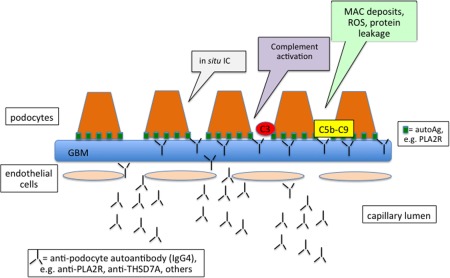Figure 4.

Mechanism of anti‐podocyte autoantibody‐mediated disease in membranous nephropathy. Circulating autoantibodies can target surface‐exposed intrinsic podocyte proteins to form in‐situ immune deposits. The functional impairment represented by proteinuria is the result of formation of the membrane attack complex (C5b‐C9, MAC), which leads to sublethal podocyte injury resulting in the activation of transcription factors encoding for mediators of fibrosis and cytoskeletal podocyte rearrangement. It also increases production of potentially nephritogenic molecules such as reactive oxygen species (ROS), proinflammatory cytokines, proteases and vasoactive molecules.
